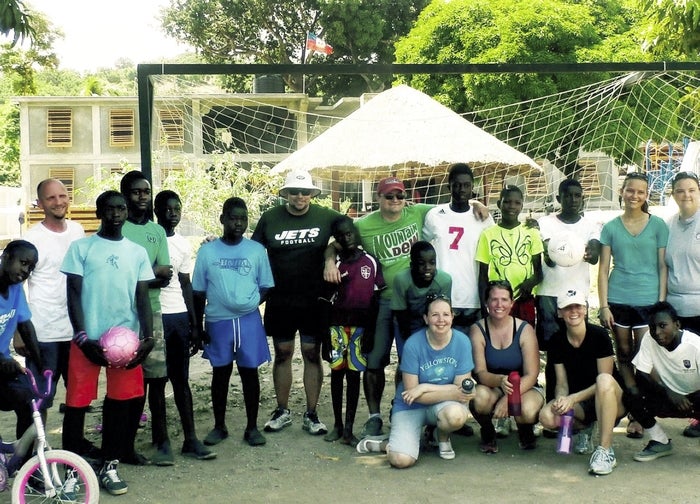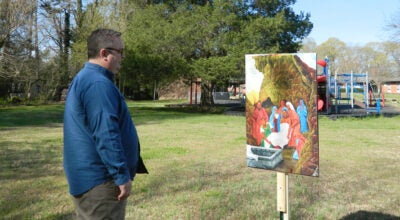A helping hand in Haiti
Published 12:00 am Saturday, October 24, 2015

- Post-soccer match photo with some of the kids of The Hands & Feet Project that we practiced and played with.
By Mark Rockwell
For the Hands & Feet Project
— Third in a series —
When I went to Haiti the first time, I had a naive notion that by moving bunk beds, painting walls, building cabinets, delivering supplies and playing with kids, I was going to save Haiti and, while I was at it, the world, too.
Well, lives did change, but, mostly, it was mine. I made valuable initial contacts with some of the kids, staff and missionaries of The Hands & Feet Project and, surely, my team accomplished helpful tasks and delivered needed supplies in addition to playing with the kids. But, it was just my first taste of Haiti and I was overwhelmed by the beauty of the people and the dramatic circumstances in which they live each day, but, the complexity and depth of Haiti’s plight, but, I failed to look deeper at how it affected them as individuals on a personal level.
On the trip I made this past July, however, with the initial shock of third-world poverty that I witnessed on the first trip behind me, the experience of being in Haiti settled down more for me. Time didn’t move as fast and I found myself with more opportunities to learn about the Haitian people as individuals. From the American missionaries that live, sweat and serve full time on the ground in Haiti managing The Hands & Feet Project’s Children’s Villages and the hired Haitian staff to the orphaned and abandoned children they care for, I was captured by their willingness to open up, extend friendship and share time in conversation with me. They blessed and challenged me in a manner far more profound than I could ever hope to benefit them with through my meager project-oriented efforts during a short-term mission trip.
Joel and Romy, who have both been raised in the care of The Hands & Feet Project over the past ten years, are two of the young men that I spent time with over the course of the week. Both are extremely intelligent, friendly and hard-working young men with real goals. One serves as a musician in the local church’s worship band while developing trade skills doing construction work and the other is pursuing additional English and additional schooling in the hopes of becoming a translator for The Hands & Feet Project. Both have opportunities available to them now as healthy, strong and intelligent young men that they’d very likely not have without The Hands & Feet Project.
Because of the chance to work, play, serve and pray alongside the people of Grand Goave and The Hands & Feet Project, my hope for the people of Haiti has become less of a surface-level humanitarian outreach and more of a passion rooted in friendship with beautiful individuals that I pray can extend and deepen through future trips. But, it’s also important that I try to raise the awareness of my fellow Americans to who the people of Haiti really are — individual, unique, hard-working human beings — and what they really need in order to move forward.
By and large, the immediate needs, at least for those in the care and employment of the Hands and Feet Project, have been met. But, what Haitians don’t have, outside the walls of The Hands & Feet Project’s Children’s Villages, is hope for the future. The Haiti that each of the orphaned and abandoned children being raised by The Hands & Feet Project will face once they age out of orphan care will still likely be, as it is now, the poorest country in the western hemisphere, sorely lacking in education and employment opportunities. Despite all of the hard work that short- and long-term missionaries do, the likely reality is that life in Haiti may very well be the same in 10 to 20 years for these kids as it was for their parents who died or abandoned them in the hopes that their children would have a better life in an orphanage where, at least, they would have food, shelter, medical care and, possibly, an education. It is this perpetual relationship that exists between lack of opportunity, desperation and hopelessness that continues to feed the orphan cycle in Haiti.
The Hands & Feet Project is, however, developing strategies to work toward a brighter future for their children and for the kids outside their walls in the local communities around their Children’s Villages. First, they established Haiti Made, which has a mission “to unite around quality products, economic sustainability, and dignified jobs to fight against Haiti’s orphan and child slavery crisis.” The older children of Hands & Feet that choose to take part, along with the hired Haitian staff, create handmade leather products, knit hats and jewelry sold online through their site at http://www.haitimade.com and on partnering Christian music groups’ merchandise tables (e.g., Newsboys and Audio Adrenaline) at concerts and events around the U.S. If more Haitian families have stable income through employment, fewer parents will opt to desert their children into the hands of orphanages and child slavery. As Haiti Made’s website states, “Charity has its place and purpose, but we have found that when buying great products made by the people of Haiti, we enter into a meaningful exchange with them that brings lasting respect, hope and dignity.” Profits from items sold by Haiti Made are then invested back into The Hands & Feet Project’s Children’s Villages, new Haiti Made products and the hiring of additional Haiti Made and Hands & Feet Project staff.
The Hands & Feet Project is also nursing a vision to provide comfortable accommodations on their property in Haiti to serve as a getaway tourist destination for groups to come enjoy and, at their discretion, engage in service projects with Hands & Feet and within the local community. The idea is that, if The Hands & Feet Project can provide comfortable accommodations with facilities and wait staff, they will be able to employ a significant number of unemployed Grand Goave residents while also feeding the local economy with tourist dollars. The mission village will also provide an opportunity, in addition to Haiti Made and a number of other apprenticeship programs they’re developing, for the older children of The Hands & Feet Project to develop valuable work skills and earn a legitimate wage, if they choose.
The beauty of the people of Haiti is just as real as the country’s deeply-rooted economic and social problems. The Hands & Feet Project has sought, over the past eleven years, to fulfill the biblical mandate to care for orphans and love “the least of these.” Now, in addition to orphan care, they’re working to weaken one of the major forces behind the ongoing orphan cycle: unemployment. But, they can do more with your help.
Learn more about The Hands & Feet Project, Haiti Made and see how you can get involved by going to www.handsandfeetproject.org for The Hands & Feet Project or www.haitimade.com for Haiti Made products. In Support of The Hands & Feet Project, go to https://www.facebook.com/BeardsHandsAndFeetProject or the blog at http://meanders.wordpress.com .



